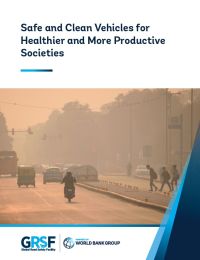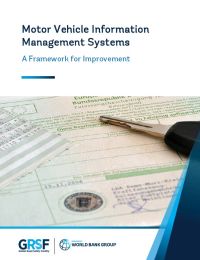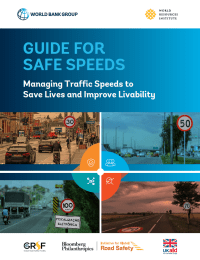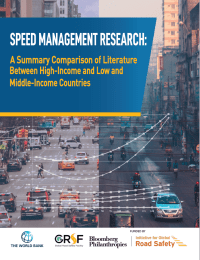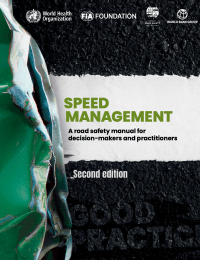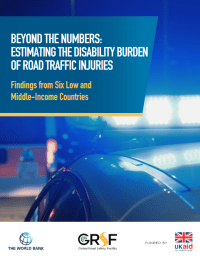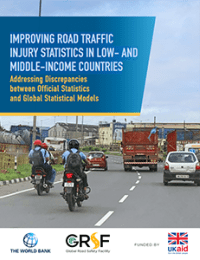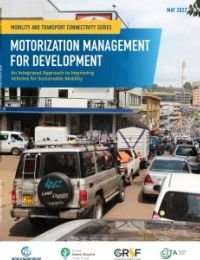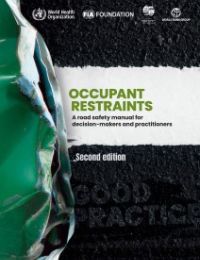Publications
1-10 of 26
-
-
Economics & Finance
Journal Article - The Value of a Statistical Life in the Context of Road Safety: A New Value Transfer Approach
May 2025
-
Road Safety Management
Motor Vehicle Information Management Systems: A Framework for Improvement
March 2025
-
Speed Management
Guide for Safe Speeds: Managing Traffic Speeds to Save Lives and Improve Livability
March 2024
-
Speed Management
Speed Management Research: A Summary Comparison of Literature Between High-Income and Low and Middle-Income Countries
February 2024
-
Speed Management
Speed Management: A Road Safety Manual for Decision-Makers and Practitioners (2nd ed.)
November 2023
-
Post-Crash Health Care
Beyond the Numbers: Estimating the Disability Burden of Road Traffic Injuries
November 2023
-
Road Safety Data
Improving Road Traffic Injury Statistics in Low- and Middle-Income Countries
November 2023
- National decision-makers recognize the issue of underreporting but tend to dismiss higher estimates by global statistical models.
- Most countries use WHO GSRRS estimates.
- National health surveys and censuses in LMICs often contain relevant information, and minor modifications can greatly improve their usage for such measurements.
- Incorporating national health survey data into global statistical models can help resolve discrepancies and increase confidence in estimates.
- Integrating epidemiological data sources into global statistical models (GBD, GHE, GSRRS) to reduce discrepancies and increase confidence in their estimates.
- Including relevant questions in upcoming national data collections to facilitate epidemiological measurements of road traffic injuries.
- Encouraging local involvement in data production for better estimates.
- Enhancing coordination between the Institute for Health Metrics and Evaluation and the World Health Organization to improve estimates and reduce inconsistencies.
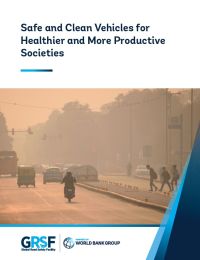
The rapid growth of motorization in emerging and developing economies brings new opportunities—but also rising health and economic risks. Safe and Clean Vehicles for Healthier and More Productive Societies presents compelling evidence that poor-quality vehicles are a major contributor to road traffic deaths, long-term disability, and air pollution.
The report emphasizes that electrification alone is not enough. Instead, countries must adopt comprehensive motorization management policies, including regulating used vehicle imports, enforcing modern safety and emissions standards, and retiring unsafe vehicles.
These strategies can significantly reduce fatalities and serious injuries, protect human capital, and promote cleaner, more resilient transport systems.
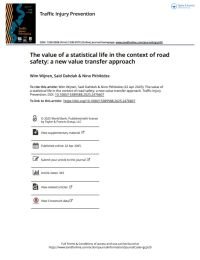
Objective: The value of a statistical life (VSL) is a key input for cost-benefit analysis (CBA) in the context of road safety and for calculations of the socio-economic costs of road crashes. However, many countries, especially low- and middle-income countries (LMIC), lack country-specific VSL estimates. To address this, value transfer is often used, where VSL estimates from other countries are adapted to local situations to estimate the VSL in the countries with no VSL estimates. This paper presents new guidance for VSL value transfer in the context of road safety.
Method: A unit value transfer approach is applied, which implies that a base VSL is determined and used to estimate the VSL in other countries. We collected VSL estimates from 32 countries worldwide to determine base VSLs for both high-income countries (HIC) and LMIC. According to the literature, the VSL is strongly correlated with income per capita. Therefore, income elasticities from the literature are applied to account for the impact of per capita income on the VSL.
Results: The resulting VSL transfer functions are VSL = 0.404*(Y/5,726)1.2 for LMIC and VSL = 3.206*(Y/42,087)0.8 for HIC, where VSL is the VSL in million USD and Y is the Gross National Income per capita (USD, 2020 prices). The VSL ranges from approximately 22,000 USD to 1.1 million USD in LMIC and from 1.2 million USD to 4.8 million USD in HIC.
Conclusions: We recommend applying this VSL transfer approach for cost-benefit analysis and road crash costing in countries lacking appropriate country-specific VSL. Moreover, this study highlights that, despite the growing interest in LMIC in research on VSL, the number of studies in these countries is still limited, emphasizing the need for more VSL studies. Finally, developing transfer functions for non-fatal injuries is recommended, which is an essential input for CBA as well.
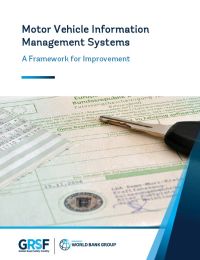
The rapid growth of motorization worldwide has brought both opportunities and challenges, impacting health, resource consumption, and accessibility. Effective management of motor vehicle fleets is crucial for maximizing benefits while minimizing negative consequences. This report presents a framework for improving Motor Vehicle Information Management Systems (MVIMS) to enhance public policy outcomes.
A well-structured MVIMS can support regulatory efforts by improving oversight of used vehicle imports, ensuring compliance with vehicle safety and emissions standards, facilitating periodic inspections, and strengthening vehicle insurance systems. The report highlights key findings from a survey of MVIMS practices in 13 low- and middle-income countries, revealing challenges in data integration, institutional coordination, and information accessibility.
By adopting best practices and strengthening governance, MVIMS can play a critical role in enhancing road safety, environmental sustainability, and transport efficiency. The report outlines a strategic pathway—Assess, Envision, Plan, Implement, and Monitor—to guide countries in developing robust MVIMS that support effective transport management.
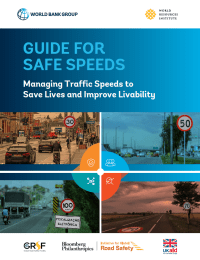
Speed is one of the main road safety risk factors and is universally recognized as the leading contributor to road fatalities and serious injuries. But there is good news: the speed problem is solvable. Interventions that are proven to be effective exist, and it is well understood where and how they should be applied.
The newly published “Guide for Safe Speeds: Managing Traffic Speeds to Save Lives and Improve Livability” outlines interventions that work and provides guidance on how to select and implement speed limits that are safe for all road users. It also explains how barriers to changing traffic speeds—which are often based on lack of knowledge or misunderstandings—can be overcome.
A primary feature of the guide is its comprehensiveness. The guide covers all types of roads—from city streets to inter-urban roads and motorways (existing or new); all types of road users—from vulnerable road users such as pedestrians and cyclists to heavy motorized traffic; all types of speed limit changes—from national general speed limits to localized changes based on risk factors; all types of challenging constraints—from lack of resources to lack of data; and all types of countries—from low-income to high-income.

Low- and middle-income countries (LMICs) have been experiencing growth in vehicle travel and mobility but have not yet realized road safety gains experienced by high-income countries. Excessive and inappropriate speed is known to be a major cause of road crashes, injuries and deaths. Thus, speed management is considered a key initiative for improving road safety outcomes worldwide and has been applied successfully in most high-income countries.
Proven interventions do not necessarily have the same impacts in LMICs, or may not be feasible to apply, due significant differences in traffic mix, road user behavior, road design and vehicle standards.
This document summarizes current available knowledge about speed, its effects on safety, mobility and emissions, along with potential safety effectiveness of speed management initiatives in the LMIC context. Knowledge gaps for LMICs are clearly referenced for further consideration.
The knowledge summary provides a useful reference for practitioners wishing to inform themselves about traffic speeds, their selection and impacts on safety outcomes, mobility and emissions. The LMIC knowledge gaps will be useful in considering future research and data priorities.
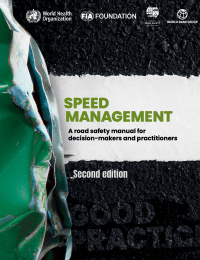
The WHO, World Bank, FIA Foundation and Global Road Safety Partnership (GRSP) produced a series of good practice manuals, following the publication of the World report on road traffic injury prevention in 2004, which provide guidance on implementation of interventions to address specific risk factors in road safety. The topics covered in the initial series of manuals were: helmets (2006), drinking and driving (2007), speed management (2008), seat-belts and child restraints (2009), data systems (2010), pedestrian safety (2013), road safety legislation (2013), powered two- and three-wheeler safety (2017) and cyclist safety (2020).
Since the series of manuals was first published, the scientific evidence base relating to various risk factors and the effectiveness of interventions have continued expanding. Contemporary research has refined our knowledge about specific risk factors, such as distracted driving, and vehicle impact speed and risk of death for pedestrians. New issues and practices have arisen, such as a tropical helmet standard and an anti-braking control standard for motorcycles. New and existing interventions have been implemented and evaluated, with increasing application in LMICs. Research attention and policy response have also increasingly been applied to emerging road safety issues including e-bikes, drugs other than alcohol, fleet safety, urban mobility, micro mobility options, air and noise pollution, public transport and technological advances.
As a result of these developments, the good practice manuals required revision so that they can continue to be key references for road safety policy implementation and research. This is particularly important, given the emphasis placed on road safety within the framework of the 2030 Agenda for Sustainable Development and because of the global impetus to reduce road deaths and injuries, resulting from the declaration of the two United Nations’ Decades of Action for Road Safety (2011–2020 and 2021– 2030). The manuals have been revised to reflect these developments as they continue to be valuable resources providing evidence-based and cost-effective solutions to save lives and reduce injuries.
The management of speed remains one of the biggest challenges facing road safety practitioners around the world and calls for a concerted, long-term, multidisciplinary response. The speed at which a vehicle travels directly influences the risk of a crash as well as the severity of injuries sustained, and the likelihood of death resulting from that crash. This manual advocates for a strong and strategic approach to creating a Safe System, with speed management at its heart. Reducing motor vehicle speeds in areas where the road user mix includes a high volume of vulnerable road users, such as pedestrians and cyclists, and on non-divided rural roads, is especially important.
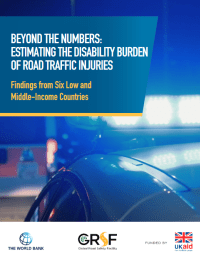
It is well-documented that road crashes claim around 1.35 million lives each year and rank as the eighth leading cause of death globally, causing huge burdens for economies, health systems, and transport networks. However, beneath the sobering fatality statistics lies a largely unexplored landscape: the staggering toll of disabilities induced by road crashes. Until now, the focus of road safety research and policy discourse has predominantly revolved around fatalities, which has limited our understanding of traffic-related injuries and disability burdens at the individual, community, and national level.
To address this critical knowledge gap, this pioneering study—involving over 2,300 patients hospitalized for road crash injuries—provides valuable insights into the prevalence, causes, and long-term impacts of crash-related disabilities. By broadening the discussion beyond fatalities to the often-overlooked issue of disability, the report paves the way for a more holistic perspective on road safety impacts, which can inform more effective road safety policies.
This report is a call to action for comprehensive and context-specific interventions that encompass both the transport and health sectors. Effective measures may include implementing safety regulations, enhancing emergency services, strengthening rehabilitative care, and expanding social safety nets to ease the financial burden on crash survivors. Collaborative efforts between governments, global and regional organizations, civil society, and other stakeholders will be indispensable.
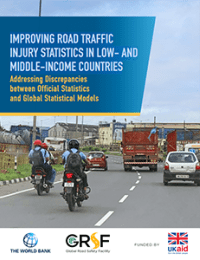
Road safety is a global health and economic issue that disproportionately affects low- and middle-income countries (LMICs). Precise data is crucial for understanding the full scope of the problem and developing effective interventions, but LMICs struggle to collect comprehensive data due to limited resources, underdeveloped health systems, and inconsistent data collection processes.
To overcome reporting gaps, three major global statistical models are utilized: The Institute for Health Metrics and Evaluation Global Burden of Disease (GBD) study, the World Health Organization (WHO) Global Status Reports on Road Safety (GSRRS), and WHO Global Health Estimates (GHE). However, discrepancies exist among these models and between them and official country statistics. They often estimate significantly higher road traffic fatalities and injuries than official LMIC statistics.
This GRSF study identifies the reasons behind statistical discrepancies and outlines strategies to strengthen modeling efforts. This involved qualitative research, a systematic review of national data availability, and four case studies in Brazil, Cambodia, Ethiopia, and Tanzania.
Key findings include:
Recommendations include:
To achieve the goal of the Second United Nations Decade of Action for Road Safety (reducing road traffic fatalities and injuries by 50% by 2030), substantial resources need to be allocated to road safety and accurate reporting and statistical estimates are required.
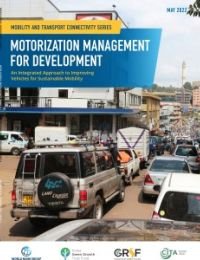
Across the developing world, countries are experiencing rapid growth in urbanization and motorization. While high motorization rates potentially meant hat more people will be able to claim the benefits of improved accessibility to goods and services as a consequence of enhanced mobility, there are questions about the sustainability of this future. Will countries be able to build and maintain infrastructure to accommodate increasing numbers of vehicles? Will the increasing number of vehicles and their characteristics support attainment of the Sustainable Development Goals (SDGs) Will they put in jeopardy countries’ ability to meet their climate commitments under their Nationally Determined Contributions (NDCs)? From a development impact standpoint, the nature of a country’s motor vehicle stock and how it grows affects three key and tangible outcomes.
First, the quality of the motor vehicle stock affects road safety outcomes—that is, the number of people killed or seriously injured in motor vehicle crashes. The characteristics of vehicles and their fitness or roadworthiness can affect fatality and serious injury outcomes. Second, the quality of the motor vehicle fleet affects air quality, particularly in cities. Motor vehicles are a key source of harmful air pollution, including carbon monoxide (CO), fine particulates (PM2.5), sulfur oxides (SOx), and ozone precursors (oxides of nitrogen and various hydrocarbons), and the amount of these pollutants they emit is directly related to how the vehicle was built and how well it is maintained. Finally, the profile of the vehicle fleet—what is the size and weight of vehicles in the fleet, how big are their engines, what kind of power control technology do they use, and how did their manufacturers engineer the technology of the vehicle to balance power with efficiency—affects the (fossil) fuel consumption of the vehicle stock as a whole, and, consequently, the greenhouse gas (GHG) emissions profile of the road transport sector.
This report presents the World Bank’s Motorization Management (MM) framework, which is intended to support client countries in the development of policies and measures aimed at managing vehicle stocks in a proactive, phased, and systematic manner to make them safer, cleaner, and more fuel efficient. The MM framework reflects a series of policy considerations and programs that can be implemented to improve the quality of fuels and vehicles in a country’s stock.
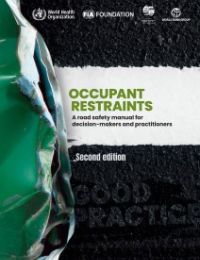
This manual provides guidance and evidence for decision-makers and practitioners that should lead to an increase in the use of vehicle occupant restraints, such as seat-belts for adults and car seats for babies and children. It draws on experience from countries that have succeeded in achieving and sustaining high levels of vehicle occupant restraint use, and builds on new evidence, including from low and middle-income countries.

